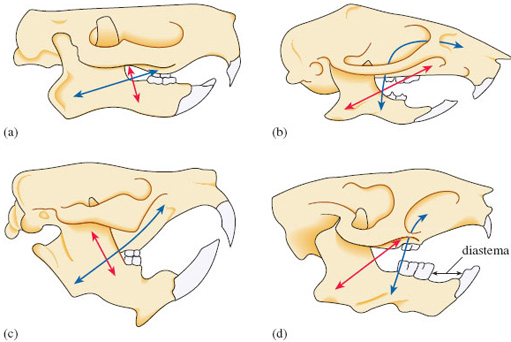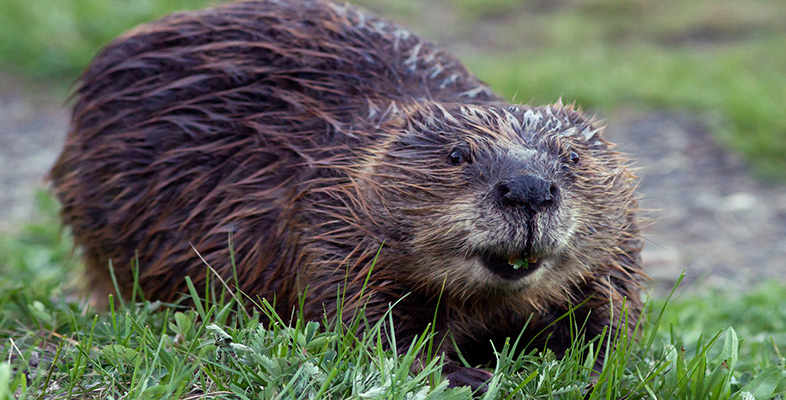2.2 Cracking nuts and other ways of eating
This section returns to the arrangement of teeth in the jaws of various mammals and uses the same representation for the dental formula as used in S182_2 Studying mammals: the insect hunters. You are not expected to remember the dental formulae of the various mammals.
We can tell a great deal about a mammal's diet, and therefore about its way of life, by studying its dentition. Before you study the armoury that enables the rodents to chisel into nuts, I'll remind you of the standard mammalian dental pattern and describe the differences found in rodent dentition.
Mammals have teeth of different types, differentiated from front to rear: incisor, canine, premolar and molar. (Where teeth are different in shape and size, the dentition is said to be heterodont.) For the hedgehog (see course S182_2) the dental formula is I3/2, C1/1, P3/2, M3/3. The pygmy shrew dental formula is different with respect to the lower incisors and premolars; I3/1, C1/1, P3/1, M3/3.
SAQ 6
What are the advantages of different types of teeth?
Answer
The differently shaped teeth are able to perform different functions. Incisors can nip or gnaw, canines can grasp, whilst molars and premolars shear and grind. Mammals have to process large amounts of food if they are to maintain their comparatively high body temperature and thus remain active. Having more 'tools' at their disposal gives the potential for more effective physical processing of food items before swallowing and 'handing over' to the digestive enzymes.
SAQ 7
The photograph of a Damaraland mole-rat [p. 76] shows the animal's incisors. How many incisors does the mole-rat possess?
Answer
The mole-rat has four incisors only.
SAQ 8
Apart from nipping off bits of tuber, how does the mole-rat use its incisors?
Answer
DA says that the mole-rat uses the front incisors 'not so much as chisels as mechanical excavators' [p. 76]. These little creatures excavate their way through soil and sand in search of a 'life-saving tuber' [p. 77].
All rodents are like the mole-rat and have only four incisors, two in the upper jaw and two in the lower jaw. As DA points out 'The wear on the incisors as they cut through the soil is particularly heavy, so it is essential that they grow fast and continuously. Consequently, the mole-rat's incisors have extremely long open roots that extend far back along the jaw, even beyond the roots of their cheek teeth' [p. 76]. These incisors are described as being rootless, as distinct from the rooted teeth described in S182_2. They retain the open pulp cavity with a good blood supply and so the teeth continue to grow throughout the animal's life. The action of opposing teeth as they gnaw and grind against one another gives the incisors chisel-sharp edges. As DA explains [p. 61], the incisor enamel is found only on the anterior (front) surfaces and enamel is harder than the underlying dentine, which consequently is more rapidly worn away on that side [p. 61]. The TV programme shows diagrammatically (at 02.52) how such sharpening is achieved.
Rodents have other distinctive dental features, also mentioned by DA. Canine teeth are entirely absent from the group. The gap between the gnawing front teeth and the chewing teeth behind is termed the diastema (Figure 1); when the lips can be drawn into this space, the mouth is effectively sealed off, so reducing the chances of swallowing any indigestible material gnawed off by the incisors. In some species the diastema provides deep pockets within which food can be temporarily stored during the to-and-fro shuttling associated with building up food hoards, an activity that is wonderfully illustrated in the TV programme. Many rodents have no premolars, though the molar teeth are often very substantial and sculptured in complex ways that promote the grinding up of plant material - features reminiscent of the dentition of the plant-eating mammals, which are highlighted in the next course in this series.
SAQ 9
To crack tough nuts, you need more than a chisel-sharp pincer action from teeth. What other features would be desirable?
Answer
Strong jaws and jaw musculature.
Figure 1 shows some features of rodent jaws and skulls and they indicate just how intricate the processes of gnawing and chewing in rodents are. The hinge of the jaw is complex. When the lower jaw is protruded forward, the incisor teeth engage, and can chisel or nip. In this position, the surfaces of the upper and lower teeth do not meet. But when the jaw slides backwards, the molars can grind the food, while the incisors hang over the lower ones, giving the animal the characteristic 'buck teeth' appearance.

The muscles of the jaw are massive and are able to produce this backward and forward movement of the jaw. The major muscle is called the masseter, consisting of two main components, which are attached (i.e. inserted) at particular points in the upper and lower jaw. Figure 1a shows the arrangement typical of some types of squirrel, with points of insertion of these muscles drawn as arrow heads. That part of the masseter represented in red can close the jaw; while the masseter muscle shown in blue can pull the jaw forward. Figure 1b-c show the very different arrangement in other rodents and although the details needn't concern us, note that in rats and mice (Figure 1b), the insertion of the masseter is more forward onto the face, with one part of the muscle passing through the eye socket onto the muzzle. Note too that the lower jaw of many rodents has a large flange, where the masseter muscle is inserted. What these side views can't show is how the two halves (i.e. left and right) of the rodent lower jaw (the mandible) sit side by side. Rather than being fused, as with many mammals, these bones are linked by a ligament, a band of flexible tissue like a strap. This independent mobility allows the lower incisors to be brought together or pushed apart, facilitating manipulations such as prising open a nut. The teeth are firmly held in their sockets and not easily dislodged.
Activity 1
Watch 'Chisellers' on the DVD from 01.55-03.33 and 05.35-08.56, and compare the behaviour of squirrels and agouti as they eat nuts. Do you see any differences in the shape of their lower jaws, or in the musculature? What other manipulations are important for a successful nutcracker?
Discussion
The feeding techniques involved are different, even to the naked eye. The agouti has a thickset head and a more massive jaw than the relatively delicate squirrel. The agouti holds the nut steady whilst the incisors gnaw persistently in one place. The squirrel appears to manipulate the nut so that a particular part of the surface can be attacked.
It seems then that a nut cannot generally be cracked unless it can be manoeuvred into the right position. You saw the squirrel using its forepaws to manipulate the white acorn before it started to gnaw; this was no random movement. As you know, the second programme extract in Activity 1 (05.35-08.56) was of a squirrel biting out the embryo before storing the remainder of the nut. Other research has shown that squirrels learn to gnaw along the weak 'seams' of a nut. Their proficiency improves with age - a result of learning, not just maturation. A squirrel reared on mashed food and not given the opportunity to handle nuts does not improve its handling technique with age.
